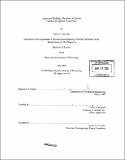Analysis of building's response to diurnal variation in ambient temperature
Author(s)
Elizondo, Hazel A. (Hazel Arlene)
DownloadFull printable version (2.556Mb)
Other Contributors
Massachusetts Institute of Technology. Dept. of Mechanical Engineering.
Advisor
Leslie K. Norford.
Terms of use
Metadata
Show full item recordAbstract
An analysis is conducted to determine the number of nodes necessary to understand the influence that ambient temperature has on a building's interior air temperature. The simple case of a wall of homogeneous material is modeled as an electrical system: the building walls are modeled as resistors capacitors, the ambient temperature as the sinusoidal input function, and the inside air temperature as the output function. An analytical solution is obtained using differential equations. Numerical examples for various building materials and a range of thicknesses are explored using MatlabTM. Of particular interest is the time delay and amplitude until the temperature of interior air peaks. The number of nodes that best describes a system is dependent on the type of material and thickness of the wall. For high-density materials such as concrete, time delays will be less than lower-density materials because delay depends on the thermal resistance and capacitance. The thicker the wall the more delay there is for the interior air to peak. There are greater increases in time delay with an increase in wall thickness and density. Polystyrene and wood had longer time delays than concrete and brick, with concrete having the overall lowest amount of phase shift and polystyrene having the longest phase shift. (cont.) For materials with higher densities, one node would be enough for wall thicknesses of 3-6 inches and two nodes for wall thickness of 10-14 inches. For better insulating material with lower densities, two nodes are appropriate for thicknesses of 3-6 inches while 10-14 inches would be best described with three nodes.
Description
Thesis (S.B.)--Massachusetts Institute of Technology, Dept. of Mechanical Engineering, 2005. Includes bibliographical references (leaf 27).
Date issued
2005Department
Massachusetts Institute of Technology. Department of Mechanical EngineeringPublisher
Massachusetts Institute of Technology
Keywords
Mechanical Engineering.